PT
Mesmo com a velocidade do scroll no Instagram, há sempre aqueles artistas / writers que me captam a atenção e Hely foi um deles.
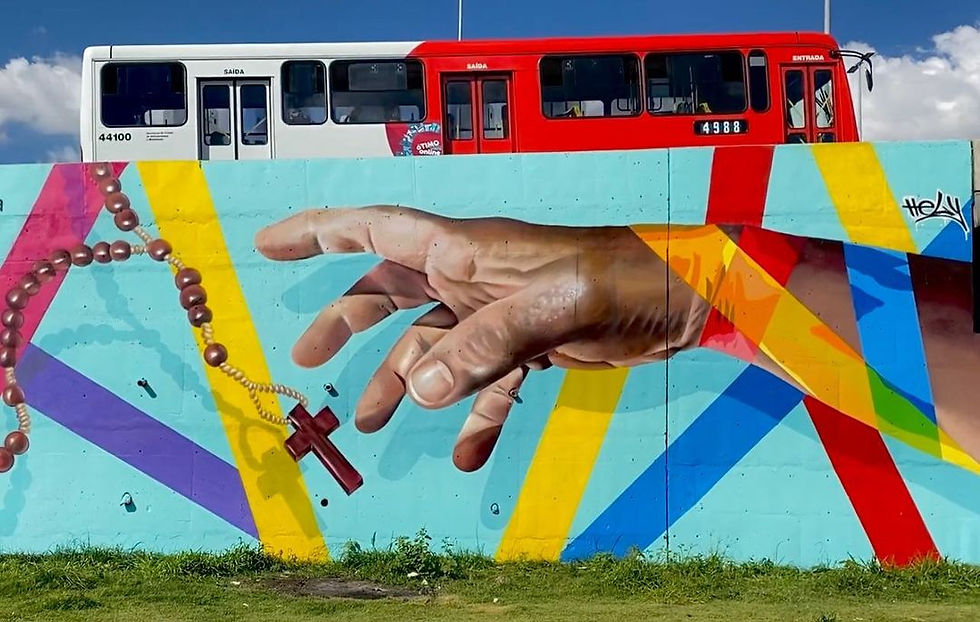
Natural de Belo Horizonte, Hely usa o seu realismo para a divulgação da história e da cultura do Brasil e das suas raízes africanas.

A sua tela preferida é a rua, porque a Arte deve ser democrática e ficar ao alcance de todos, sobretudo das classes mais desfavorecidas.
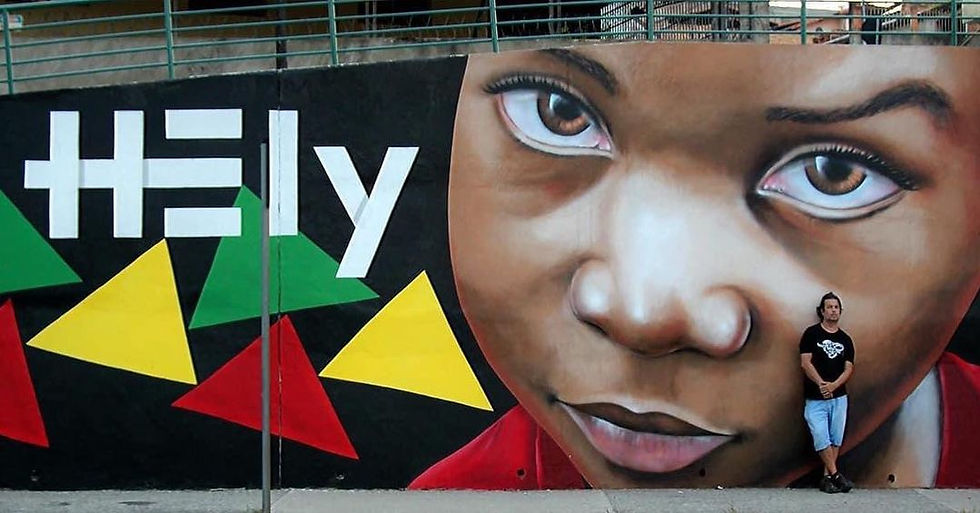
Nesta entrevista podem ficar a conhecer o artista, a sua obra e o seu trabalho junto da comunidade. Espero que gostem.
Antes de mais, fala-nos um pouco sobre ti.
Meu nome é Hely Costa, mais conhecido como Hely. Sou artista visual, arte
educador e Writer desde os anos 90. Minha técnica de pintura é o realismo e
minha inspiração é pela cultura afro-brasileira e pelas histórias de pessoas
comuns que vivem em vilas e favelas do Brasil.
Nos meus trabalhos atuais, utilizo outras técnicas, como, por exemplo, vetores em formas de fitas que entrelaçam o personagem e que fazem referência à cultura do Congado Mineiro de matriz africana.
Tens formação em arte?
Sim! Sou graduado em Desenho e Plástica pela Universidade Estadual de Minas
Gerais – UEMG e Pós-graduado em Ensino e Pesquisa no Campo da Arte e da
Cultura na Escola de Artes Guignard – UEMG.
Quando começou o teu interesse pelo(a) graffiti / street art e quais foram as tuas
influências na altura?
Comecei a interessar pelo Graffiti no final dos anos 80 e minha principal referência foi
a Tats Cru. Outros artistas internacionais também me influenciaram, mas o que me fez
entrar de cabeça no mundo da arte de rua foi ver um painel sendo produzido pelo
muralista francês Hugues Desmaziéres na cidade onde moro, na década de 90. Daí pra
frente, não saí mais desse mundo.
Em quantos países já pintaste?
Além do Brasil, pintei nos Estados Unidos, no Bronx em NY, e justamente ao lado da minha influência Tats Cru.
Recentemente, fui convidado a pintar no Haiti e Senegal.

Quais são os teus locais / cidades favoritos para pintar?
Em Belo Horizonte, minha cidade natal, e no Rio de Janeiro, em um evento internacional
que acontece todo ano.
Como é o teu processo criativo e onde vais buscar as inspirações para as tuas obras?
Inspiro muito na cultura afro-brasileira. Sou um estudioso da história da arte e da
cultura dos povos que considero importante para a formação cultural do Brasil. Povos
que carregam muita história e que gosto de contar através das artes visuais.
Quais são os ingredientes para um bom dia de pinturas?
Acho que os locais onde vou produzir minha arte. Locais como viadutos e espaços
abandonados pelo poder público, principalmente em vilas e favelas, pois sei que
nesses lugares minha arte vai ser bem recebida e prestigiada por pessoas comuns e
que precisam de cores para enfrentar o dia-a-dia.
Pintas com sketch ou freestyle?
Normalmente pinto com sketch utilizando várias técnicas, mas também pinto
freestyle. Mas pela técnica que escolhi, no caso o realismo, faço estudos antes das peças
serem produzidas nos muros.
Preferes pintar sozinho ou em grupo?
Gosto de pintar sozinho às vezes. Mas em grupo é legal também, pois acabo
conhecendo outras pessoas, aprendendo outras técnicas e fazendo amizades.
O que toca na tua playlist quando pintas?
Gosto muito de NAS e música brasileira. Mas na maioria das vezes não ouço nenhuma
música, pois sou muito comunicativo e sempre dou atenção para pessoas que passam e
que perguntam sobre o meu trabalho.
Qual é aquela que consideras ser a tua melhor peça?
As que têm crianças e idosos como modelos, que contam um pouco da história local e
do nosso povo e carregadas de cores vibrantes que chamam a atenção.
Podes falar-nos do conceito que está na base do projeto Arte Favela nos Becos?
O objetivo do Projeto Arte Favela Nos Becos, acho que missão também, é guardar o
conhecimento no outro e que as parcerias são mais eficazes quando são realizadas
entre pessoas.
O Arte Favela surgiu em 2003 no Bairro Goiânia, Zona Nordeste de Belo Horizonte,
Brasil. Nessa época, existiam no Bairro muitos conflitos entre a juventude local, por
conta do tráfico de drogas e, talvez por ser afastado do centro da cidade, o Bairro
sofria com o descaso do poder público. Não haviam espaços culturais e as escolas eram alvos da violência constante. Foi aí que percebi o interesse de vários jovens em aprender sobre a arte e a cultura de rua.
O pontapé inicial foi esses jovens me procurarem. Estava no meio de um curso superior de Licenciatura em Desenho e Plástica e já estava me familiarizando com a prática de ensino. Aí, comecei a reunir, como voluntário, com esses jovens na rua mesmo e ensiná-los sobre arte, cultura e a história da comunidade. Acreditava que essa forma de aprendizagem poderia envolvê-los, por se tratar de interesse juvenil e ter tudo a ver com a identidade cultural deles. E já se passaram 20 anos que o projeto é bem-sucedido nos becos e vielas das comunidades periféricas da cidade.
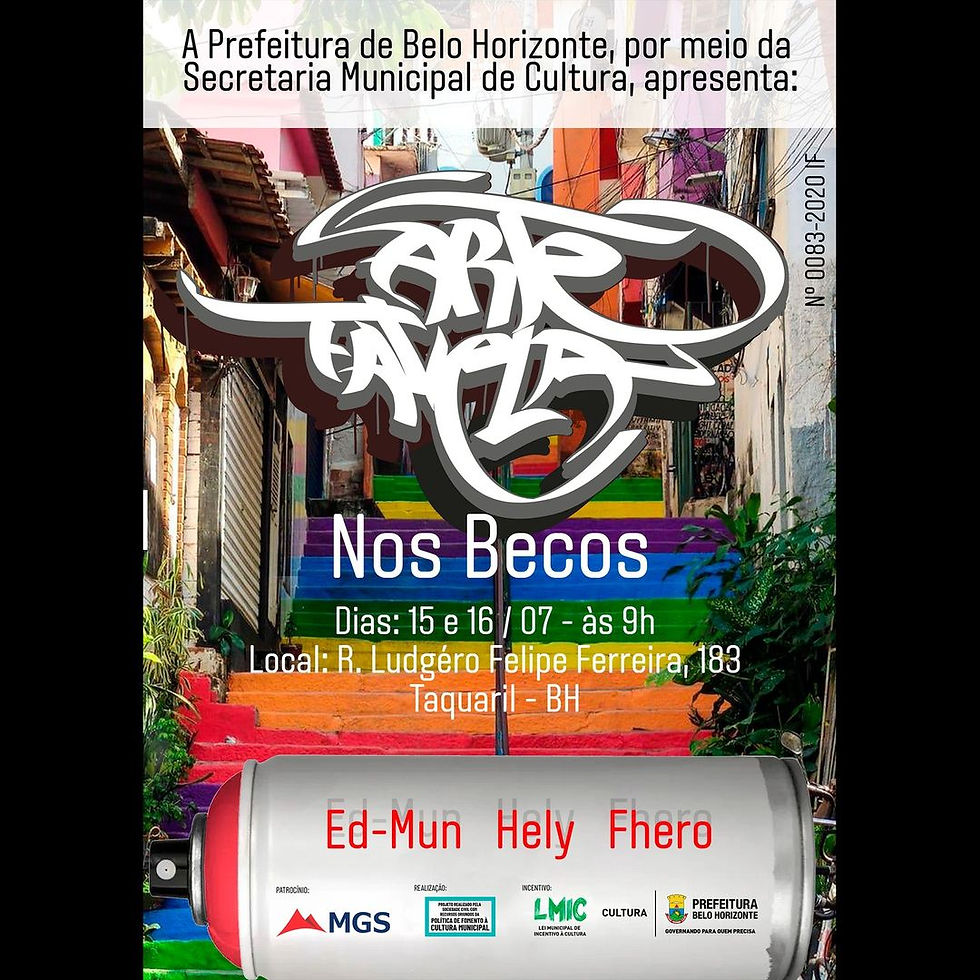
Como descreves o panorama atual do graffiti e da street art no Brasil?
Acho que está evoluindo muito rapidamente. Tem muitos artistas de nível
extraordinário e que são referência internacional. Acredito que o Brasil, por ser um
país de diferentes culturas e muito colorido, reflete e chama muita atenção pelo mundo
afora.
Qual é o teu top 3 de writers / artistas brasileiros?
Edmun: Com quem aprendi muita coisa, principalmente como pessoa, e por quem tenho muito respeito.
Sérgio Ilídio: Outro baita artista e pessoa sensacional com quem também aprendi muita coisa e sempre compra minhas ideias.
Rafael Furlan: Sem palavras para descrever essa cara. Artista sensacional e um ser
humano magnífico.
Tem muitos outros que se falar aqui não vai caber nessa entrevista, rs. Mas são pessoas
que fazem parte da minha história como artistas e que vou levar pro resto da minha
vida.
E de writers / artistas estrangeiros?
Com que writers / artistas gostarias de fazer uma peça conjunta?
Hum! Não tenho uma preferência, acho que desde os que estão começando e outros
que estão no nível técnico avançado. Não consigo diferenciar isso, sabe? Acho que a
arte de rua é um aprendizado antes de mais nada. E, muitas vezes, você aprende com
quem está começando e isso é muito legal.
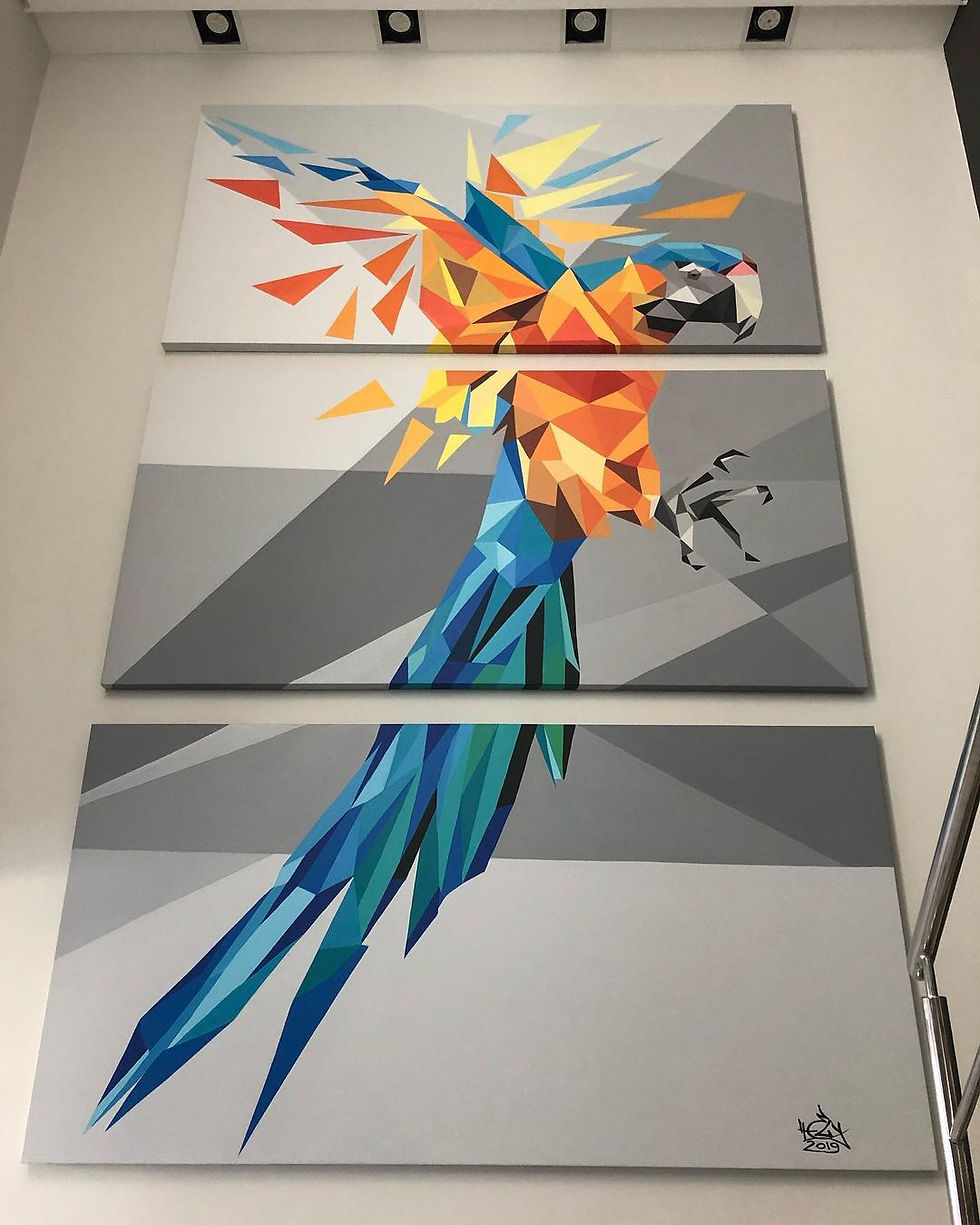
Também pintas em tela? Já fizeste alguma exposição?
Sim! Também já fiz exposições na cidade onde moro, mas os trabalhos que considero
mais relevantes são os produzidos na rua. Acho que são mais democráticos e mais
coerentes com minha ideologia.
Quais são os teus planos / projetos futuros?
Viajar o mundo e levar um pouco do que eu aprendi e colorir outros espaços. Estou
aberto a convites, ein! Rs.
Tens alguma história que queiras partilhar?
Acho que uma história em particular não, mas uma dica sim! A arte de rua acredito
ser a arte mais democrática do mundo. Pessoas comuns têm acesso a ela e os
aprendizado entre artistas são intensos. Se você tem conhecimento, guarda esse
conhecimento no outro. Isso faz você se tornar um artista completo. Com certeza,
você aprendeu algo que utilizou nas suas pinturas na rua de forma gratuita e
voluntária, não justifica você guardar esse conhecimento só pra você.
Cumprimentos / agradecimentos?
Agradeço pelo convite do Da Chic Thief por essa oportunidade de entrevista, me senti
honrado. Agradeço, imensamente, à minha esposa Jane e meu filho Matheus por
acreditarem no meu sonho, às comunidades que sempre me recebem com carinho,
respeito e admiração e a todos / todas que fizeram e fazem parte da minha
trajetória como artista.
Agradeço de coração! A arte não para!
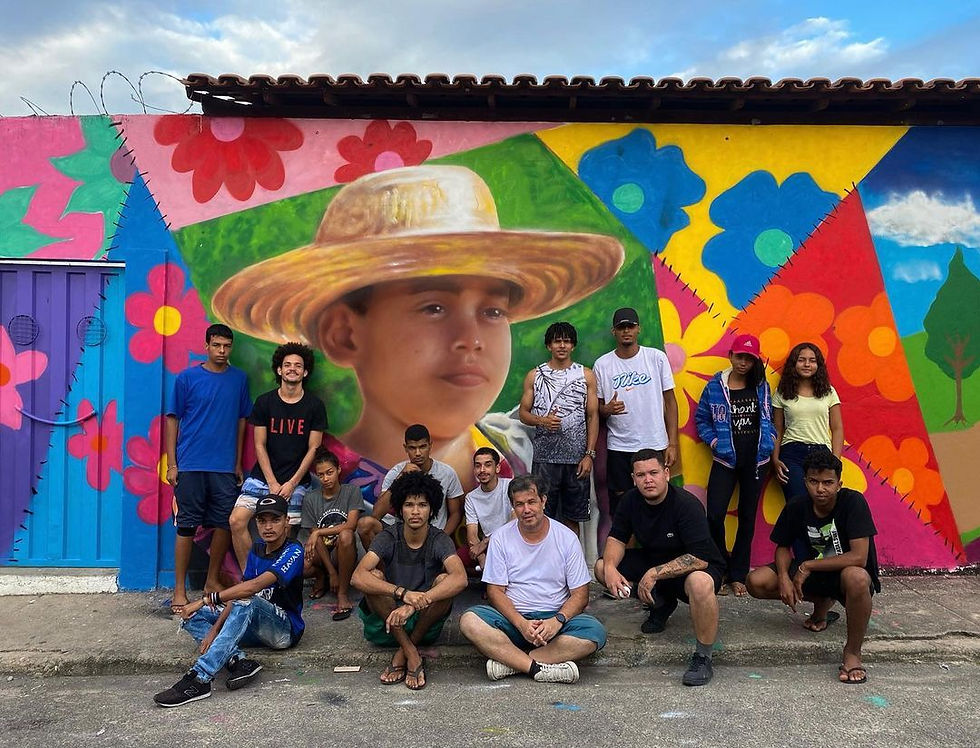
Fotografias e vídeos: Hely
Photos and videos: Hely
ENG
Even with the speed of scrolling on Instagram, there are always those artists/writers that capture my attention and Hely was one of them.
Born in Belo Horizonte, Brazil, Hely uses his realism to promote the history and culture of Brazil and its African roots.
His favorite canvas is the street, because Art must be democratic and accessible to everyone, especially the most disadvantaged classes.
In this interview you can get to know the artist, his work and his connection to the community. Hope you like it.
First of all, tell us a little about yourself.
My name is Hely Costa, better known as Hely. I'm a visual artist, art educator and Writer since the 90s. My painting technique is realism and my inspiration is the afro-brazilian culture and the stories of people people who live in the villages and favelas of Brazil. In my current jobs, I use other techniques, such as, for example, vectors in the form of ribbons that intertwine the character and make reference to the culture of Congado Miner of African matrix.
Do you have art training?
Yes! I have a degree in Design and Plastics from the State University of Minas Gerais – UEMG and Postgraduate in Teaching and Research in the Field of Art and Culture at the Guignard School of Arts – UEMG.
When did your interest in graffiti / street art start and what were your height influences?
I started to be interested in Graffiti at the end of the 80's and my main reference was the Tats Cru. Other international artists also influenced me, but what made me entering headlong into the world of street art was to see a panel being produced by French muralist Hugues Desmaziéres in the city where I live, in the 90s. Forward, I never left this world.
In how many countries have you painted?
In addition to Brazil, I painted in the United States, in the Bronx in NY, and right next to my influence Tats Cru.
Recently, I was invited to paint in Haiti and Senegal.
What are your favorite places/cities to paint? In Belo Horizonte, my hometown, and in Rio de Janeiro, at an international event that happens every year. What is your creative process like and where do you get inspiration for your works? I am very inspired by Afro-Brazilian culture. I am a student of art history and culture of peoples that I consider important for the cultural formation of Brazil. Peoples that carry a lot of history and that I like to tell through the visual arts.
What are the ingredients for a good paint day? I think the places where I will produce my art. Places such as viaducts and spaces abandoned by the government, mainly in towns and favelas, because I know that in these places my art will be well received and honored by common people and who need color to face the day-to-day. Do you paint with sketch or freestyle? I usually sketch paint using various techniques, but I also paint freestyle. But due to the technique I chose, in this case realism, I do studies before the pieces to be produced on the walls.
Do you prefer to paint alone or in a group? I like to paint alone sometimes. But in a group it's cool too, because I end up meeting other people, learning other techniques and making friends.
What plays on your playlist when you paint? I really like NAS and Brazilian music. But most of the time I don't hear any music, because I am very communicative and I always pay attention to people passing by and who ask about my work.
What do you consider to be your best piece? Those that have children and the elderly as models, that tell a little about the local history and of our people and loaded with vibrant colors that call attention.
Can you tell us about the concept behind the Arte Favela nos Becos project? The objective of the Favela Nos Becos Art Project, I think it's also a mission, is to keep the knowledge in the other and that partnerships are more effective when they are carried out between people. Arte Favela emerged in 2003 in Bairro Goiânia, in the Northeast of Belo Horizonte, Brazil. At that time, there were many conflicts in the neighborhood between the local youth, for account of drug trafficking and, perhaps because it is far from the city center, the Bairro suffered from the neglect of the public power. There were no cultural spaces and schools were targets of constant violence. That's when I noticed the interest of several young people in learning about street art and culture. The kickoff was these young people looking for me. I was in the middle of a degree course in Drawing and Plastics and I was already familiarizing myself with the practice of teaching. Then, I started meeting, as a volunteer, with these young people on the street and teaching them about art, culture and the history of the community. I believed that this form of learning could involve them, as it was of youth interest and had everything to do with their cultural identity. And it's been 20 years since the project has been successful in the alleys of the city's peripheral communities.
How would you describe the current scenario of graffiti and street art in Brazil? I think it's evolving very quickly. There are many high-level artists extraordinary and which are an international benchmark. I believe that Brazil, as a country of different cultures and very colorful, reflects and draws a lot of attention around the world out.
What is your top 3 Brazilian writers / artists? Edmun: From whom I learned a lot, especially as a person, and for whom I have a lot of respect. Sérgio Ilídio: Another great artist and sensational person from whom I also learned a lot and always buys my ideas. Rafael Furlan: No words to describe this guy. Sensational artist and a magnificent human being. There are many others that if talked about here will not fit in this interview, lol. But they are people that are part of my history as artist and that I will take with me for the rest of my life.
What about foreign writers / artists? Tats Cru, FX Crew, Maclain Crew, Jorit, Smoe Nova, among others. Which writers / artists would you like to do a joint piece with? Hmm! I don't have a preference, I think from those who are starting and others who are at the advanced technical level. I can't tell it apart, you know? I think that street art is learning first and foremost. And often you learn from who is starting and that's really cool.
Do you also paint on canvas? Have you ever had an exhibition?
Yes! I've also done exhibitions in the city where I live, but the works I consider most relevant are those produced on the street. I think they are more democratic and more consistent with my ideology.
What are your future plans/projects?
Traveling the world and taking a little of what I learned and coloring other spaces. I am open to invitations, eh! Lol.
Do you have a story you want to share?
I don't think a particular story does, but a hint does! street art i believe to be the most democratic art in the world. Ordinary people have access to it and the learning among artists are intense. If you have knowledge, save this knowledge in the other. It makes you become a complete artist. For sure, you learned something that you used in your street paintings for free and voluntary, it does not justify you keeping this knowledge just for yourself.
Greetings/thanks?
Thank you to Da Chic Thief for the invitation for this interview, I felt honored. I am immensely grateful to my wife Jane and my son Matheus for believe in my dream, to the communities that always receive me with affection, respect and admiration and to everyone who was and is part of my trajectory as an artist.
Thank you from the heart! Art doesn't stop!






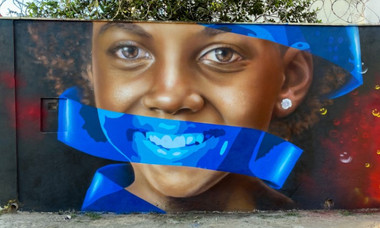











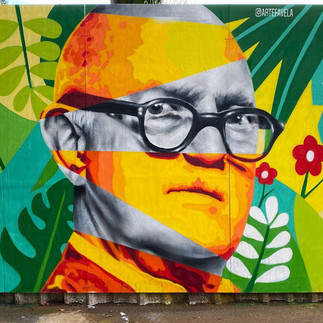
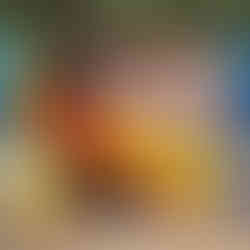













Comments